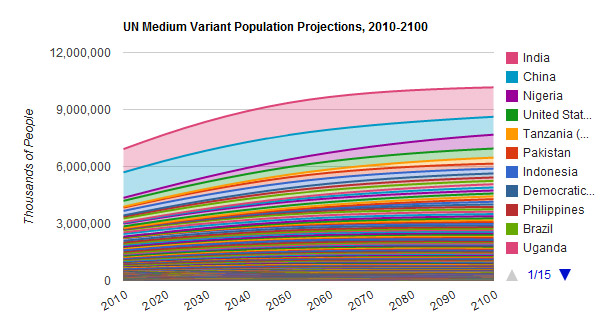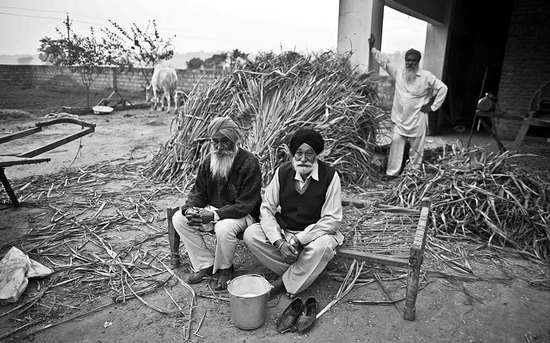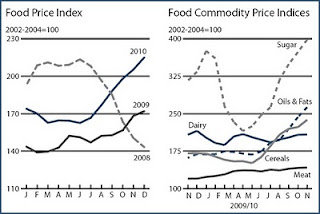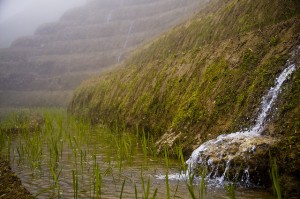-
Water: Asia’s New Battleground
›“Asia faces a daunting water crisis,” warns Brahma Chellaney, professor at the Center for Policy Research (New Delhi) and author of the new book, Water: Asia’s New Battleground. It is a crisis that imperils the region’s economic and political rise, and that deepens environmental risk in a part of the world marked by melting glaciers and densely populated coastal areas.
In his book, Chellaney, regarded as one of India’s most distinguished strategists, surveys the water landscape across Asia; examines the security implications of water-based territorial disputes; and offers policy recommendations to help prevent water conflict. On September 12, Chellaney spoke about Water at a Wilson Center event organized by the Asia Program and co-sponsored by the China Environment Forum and Environmental Change and Security Program. Steven Solomon, a journalist and author who last year published Water: The Epic Struggle for Wealth, Power, and Civilization, offered commentary.
According to Chellaney, Water “fills a void in the literature” by, for the first time, focusing on water issues across the entire continental region of Asia – an immense expanse that includes not only Northeast, Southeast, and South Asia, but also Central Asia and the Middle East. The book, he explained, defines Asia “as it looks on a map.”
The World’s Dam Center
What drives the water crisis in this vast region? One factor is population. Asia is the world’s largest and most populous continent but also the most water-deficient; its freshwater levels per capita are one-third those of Europe’s, and slightly less than Africa’s. Another is tied to economic development. Asia is the world’s fastest developing continent, yet its most rapidly developing nations, particularly India and China, are already afflicted by serious water challenges.
Rising income levels and attendant growth in consumption rates are additional drivers. Asians are consuming more resources, including meat, which requires prodigious amounts of water to produce. A fourth factor is intensive irrigation. Seventy percent of the world’s total irrigation originates in Asia, and 80 percent of the region’s “water withdrawals” are allocated to agriculture. (The latter figure is only 30 percent in Europe.) Such large-scale irrigation has enabled Asia to evolve from “a land of recurrent famine” to a major food exporter, yet it has also spawned ruinous agricultural conditions such as waterlogging and soil salinity.
Chellaney contended that Asia’s water ills can also be attributed to the “large-scale impoundment of water” by dams, barrages, and other storage-creating structures. Asia is the world’s “dam center,” he said, with China boasting half the world’s dams and now planning to construct “mega dams,” including one “higher than the Eiffel Tower.” Impounding water triggers riverwater depletion, which in turns promotes “the reckless use” of sub-surface groundwater resources, said Chellaney. With water tables plummeting, millions of groundwater pumps are depleting what used to be a pristine and plentiful resource.
“We Need Better Politics”
In a region rife with transboundary rivers yet devoid of mechanisms to promote transboundary water-sharing, Asia’s water troubles pose grave geopolitical risks.
According to Chellaney, “water wars” are already being waged across the region via non-military means, fostering mistrust and hampering efforts toward greater cooperation. He argued that in order to forestall water conflict, Asia must develop a set of norms on shared resources based on the 1997 UN Convention on the Non-Navigational Uses of International Watercourses – the only available instrument for international water management. Chellaney also called for the creation of “inclusive water institutions,” that emphasize transparency and dispute settlements, and for the adoption of “holistic planning” on central and provincial governmental levels that aim for better water efficiency.
Playing devil’s advocate, Solomon faulted Chellaney for according insufficient attention to Asia’s crisis of energy – a resource that, he pointed out, is “extraordinarily water-intensive.” He also countered Chellaney’s criticism of dams by observing that Asia desperately needs storage – a deficiency that makes the region highly vulnerable to drought. And he questioned whether China’s dam-building activities on the Brahmaputra River truly imperil lower riparian India’s water security, noting that only 15 percent of the river’s flows entering India are impacted by Chinese dams.
Ultimately, Chellaney said, alleviating Asia’s water crisis will also require improving the region’s poor political environment. While Asian economies are coming together, its politics are more divided. Transboundary water cooperation – and any treaty meant to undergird it – cannot be expected to last if co-riparians do not get along. “We need better politics,” he concluded.
Event ResourcesMichael Kugelman is a program associate with the Wilson Center’s Asia Program.
Photo Credit: David Hawxhurst/Wilson Center. -
India’s Quest for a Lower Carbon Footprint
›
Between 1994 and 2007, India reduced its carbon dioxide emissions by 35 percent. As a result, the country’s emissions per capita now register at just over a ton per year – less than China (nearly five tons) and much less than the United States (18 tons). On May 10, Wilson Center Public Policy Scholar Ajay Shankardiscussed how India made these reductions, and what the nation plans to do to bring them down further in the decades ahead.
According to Shankar, several factors account for the 35 percent reductions. One is market-based, with high costs having discouraged heavy carbon-based energy consumption. India levied a “huge de facto” carbon tax on all commercial and industrial uses of electricity, which led to prices as much as 80 percent higher than the cost of supply. Another reason is legislation: New Delhi passed a robust energy conservation law. The private sector was a major contributor to the reductions; Shankar pointed out that India is now the world’s largest hub for small fuel-efficiency vehicles, as embodied by the Tata Motors corporation’s Nano car.
Shankar acknowledged the need for further carbon reductions. As India’s economic growth continues and its citizens become wealthier, carbon emissions will likely increase as more people buy cars and invest in air conditioning. Accordingly, the country has announced its intention, by 2020, to lower emissions by 20 to 25 percent from 2005 levels. He identified two carbon-reducing “opportunities” for India in the coming decades. One is to make irrigation more energy-efficient through the use of solar energy.
Another opportunity lies in India’s cities, where 300 to 400 million people are expected to flock over the next two to three decades. Urbanization presents a considerable carbon challenge, given the proliferation of carbon-emitting vehicles and AC units envisioned by such migration. Shankar spoke of the need for “smart cities” replete with “green buildings,” parks, and electric vehicles. He argued that India has created these types of cities before – including Chandigarh, the capital of Punjab Province, back in the 1950s.
Shankar stated that solar and nuclear energy constitute the “game-changers” for lessening the country’s carbon emissions. New Delhi hopes to generate 20,000 megawatts of solar capacity by 2020, with projections of grid parity by 2017 – meaning that in just several years, solar power could be as cheap to generate as fossil-fuel-driven electricity. He also underscored the priority New Delhi places on nuclear energy, noting that Prime Minister Manmohan Singh was willing to stake his political survival on the passing of a controversial civil nuclear deal with Washington because of nuclear’s environmental benefits. Shankar insisted that the Indian government will not be deterred by Japan’s recent nuclear crisis.
While Shankar described New Delhi’s 20 to 25 percent reductions goal as “ambitious,” he contended that he is more optimistic than he would have been several years ago about India’s prospects for attaining that objective. India, he concluded, must “rule out no option, and pursue every option intelligently.”
Michael Kugelman is program associate with the Asia Program at the Woodrow Wilson Center.
Photo Credit: “Tata nano,” courtesy of flickr user mjaniec. -
Ten Billion: UN Updates Population Projections, Assumptions on Peak Growth Shattered
›May 12, 2011 // By Schuyler NullThe numbers are up: The latest projections from the UN Population Division estimate that world population will reach 9.3 billion by 2050 – a slight bump up from the previous estimate of 9.1 billion. The most interesting change however is that the UN has extended its projection timeline to 2100, and the picture at the end of the century is of a very different world. As opposed to previous estimates, the world’s population is not expected to stabilize in the 2050s, instead rising past 10.1 billion by the end of the century, using the UN’s medium variant model.
-
Michael Kugelman, World Politics Review
The Gathering Global Food Storm
›March 28, 2011 // By Wilson Center StaffThe original version of this article, by Michael Kugelman, appeared on World Politics Review.
In India’s vibrant capital, food seems to be everywhere – from bustling fruit and vegetable markets and greasy kebab stalls, to sumptuous platters in rooftop restaurants and dilli ki chaat, Delhi’s ubiquitous street snacks. Poor street vendors and high-end chefs alike offer a multitude of culinary options to keep the city – and its array of visiting tourists, diplomats and business leaders – well-fed.
Yet behind this apparent culinary prosperity lies rampant food insecurity. Food-related inflation in India soared above 18 percent in December, sparking street protests over high onion prices. Today, food-related inflation remains high, at nearly 12 percent. In a nation where at least 250 million subsist on less than a dollar a day, even modest price rises have a devastating impact on incomes and livelihoods. Yet, when food prices fall, India’s small farmers suffer. Already crippled by debt and encumbered by water shortages, 200,000 of them have committed suicide over the past 13 years.
India is not alone in this story. Just a few years removed from the 2007-2008 global food crisis, the world is once again experiencing the telltale drivers of acute food insecurity: rising prices of both food and oil, low agricultural yields, destructive weather and unquenchable demand. Once again, nations are banning exports in an effort to keep prices down at home – even as such policies drive up food costs in global markets. The consequences can be seen from Bolivia, where top government officials are hoarding food in their homes, to the Middle East, where the rising cost of basic foodstuffs has become a rallying cry for revolution.
Continue reading on World Politics Review.
Michael Kugelman is a program associate for the Asia Program at the Wilson Center and lead editor of Hunger Pains: Pakistan’s Food Insecurity and Land Grab? The Race for the World’s Farmland.
Sources: The Economist, India’s Contemporary Security Challenges, CNN, The Washington Post.
Photo Credit: Adapted from “India’s Food Crisis,” courtesy of flickr user lecercle. -
Congressional Report on Avoiding “Water Wars” in Afghanistan and Pakistan
›March 15, 2011 // By Schuyler Null“Water plays an increasingly important role in our diplomatic and national security interests in [Central and South Asia], and we must ensure that our approach is carefully considered and coordinated across the interagency,” begins a new staff briefing, Avoiding Waters Wars: Water Scarcity and Central Asia’s Growing Importance for Stability in Afghanistan and Pakistan, prepared for the Senate Foreign Relations Committee. “As water demand for food production and electricity generation increases, in part as a result of the quickening pace of climate change, so too must our efforts to provide water security,” write the authors.
The report focuses mainly on Afghanistan and Pakistan but also considers “the interests in the shared waters by India and the neighboring five Central Asian countries – Uzbekistan, Tajikistan, Kazakhstan, Kyrgyzstan, and Turkmenistan.”
ECSP is cited twice in the report, both from “Water Can Be a Pathway to Peace, Not War,” in ECSP Report 13:The Navigating Peace Initiative’s Water Conflict and Cooperation Working Group correctly summarized the current state of water use by saying, “water use is shifting to less-traditional sources such as deep fossil aquifers and wastewater reclamation. Conflict, too, is becoming less traditional, driven increasingly by internal or local pressures or, more subtly, by poverty and instability. These changes suggest that tomorrow’s water disputes may look very different from today’s.”
And again in breaking down the notion of impending water wars:Given the important role water plays in Central and South Asia as a primary driver of human insecurity, it is important to recognize that for the most part, the looming threat of so-called “water wars” has not yet come to fruition. Instead, many regions threatened by water scarcity have avoided violent clashes through discussion, compromise, and agreements. This is because “[w]ater – being international, indispensable, and emotional – can serve as a cornerstone for confidence building and a potential entry point for peace.”
USAID’s “Changing Glaciers and Hydrology in Asia: Addressing Vulnerabilities to Glacier Melt Impacts,” which was launched here at the Wilson Center last fall, also made an appearance:Central Asia and India face critical challenges in monitoring glaciers and tracking changes, particularly differences from year to year. As USAID’s report “Changing Glaciers and Hydrology in Asia: Addressing Vulnerabilities to Glacier Melt Impacts” noted, “[t]he review of scientific information about glacier melt in High Asia revealed, first and foremost, a lack of data and information, a lack that hampers attempts to project likely impacts and take action to adapt to changed conditions.” The United States should engage in collaborative glacier monitoring programs and those that develop local or sub-national water monitoring capacity.
The report concludes that “water scarcity, coupled with how governments address these challenges,” can either exacerbate conflict or promote cooperation in the region. It’s also worth noting that the authors specifically mention the links between increased water use and growing populations in the region, specifically with regard to India and Pakistan:With a population already exceeding 1.1 billion people and forecasts indicating continued growth to over 1.5 billion by 2035, India’s demand for water is rising at unprecedented rates.
The drive to meet energy and development demands from both countries has led to plans for extensive hydrological projects that could spark tensions between the two over the Indus Waters Treaty (which has withstood four Indo-Pakistani wars).
The authors praise the attention given to the matter thus far by the Obama administration, but they also write that “although it is still too early to determine the impacts of our efforts in the broader region, now is the time to begin evaluating water-related trends” at a more systematic level.
Sources: U.S. Senate Committee on Foreign Relations. -
Mapping the Hot Spots of the 2010/11 Food Crisis
›If you’ve taken a trip to the supermarket lately or scanned the headlines you may have noticed something: Food prices are on the rise. Worldwide, food prices are on track to reach their highest point since their peak in 2008. Using data from the Food and Agriculture Organization (FAO), the International Food Policy Research Institute (IFPRI), and the World Bank, the Environmental Working Group (EWG) and ActionAid have collaborated to create an interactive world map called, “Hot Spots in the Emerging Global Food Crisis.”
The focus of the map is to highlight the 52 most at-risk countries where increases in staple food prices could tip the scales of stability. There are three variants of the map to choose from: countries at risk which depend on imported cereals, countries where prices are already increasing (featured above), and countries with vulnerable economies and high rates of hunger.
Food prices have become a hot topic of conversation lately for their alleged role in the instability that is rocking the Middle East/North Africa region. But the Middle East is not the only area affected: Besides in Algeria, Tunisia, Morocco, Jordan, and Egypt, food-related riots and protests have also broken out in Mozambique, Bolivia, and India. As the map’s accompanying text puts it, these food riots “feed deeper discontent about economic inequalities and hunger and help give rise to revolutions that can topple governments, as in Tunisia and Egypt.”
Scrolling over a country reveals more information, like, for example, the specific percentage increases in the price of wheat or rice over the past year (wheat prices have risen 15.9 percent in China vs. 54 percent in Kyrgyzstan) or the amounts of corn, soybean, and wheat annually imported and exported (Afghanistan exported 908 million metric tons of wheat in 2010 while Egypt imported 4,978).
Users can also click on vulnerable countries to see how many people are malnourished and their per capita income per day. In the Democratic Republic of the Congo, for example, an estimated 42 million people were undernourished between 2005 and 2007, and the average person lives on $0.28 per day. According to EWG and ActionAid, the total number of people living in extreme poverty rose by 25 million in 2008 during the last global food crisis. Since June 2010, the start of the current upward trend in prices, the World Bank estimates that 44 million people have fallen into extreme poverty.
One recommendation from EWG and ActionAid for developed countries and the United States in particular: Stop looking to biofuels as an energy option. In their view, “spending scarce taxpayer dollars to shift crops from food to biofuels at the expense of hungry people and already stressed resources like soil, water, and air is unsustainable.”
Image Credit: Map courtesy of the Environmental Working Group and ActionAid, and Food Price Index and Food Commodity Indices, extracted from Global Food Price Monitor, January 2011, courtesy of the Food and Agriculture Organization.
Sources: ActionAid International, BBC News, CNN, the Environmental Working Group, The European Union Times, Time, Voice of America, World Bank. -
Elizabeth Malone on Climate Change and Glacial Melt in High Asia
› “There’s nothing more iconic, I think, about the climate change issue than glaciers,” says Elizabeth Malone, senior research scientist at the Joint Global Change Research Institute and Pacific Northwest National Laboratory. Malone served as the technical lead on “Changing Glaciers and Hydrology in Asia: Addressing Vulnerability to Glacier Melt Impacts,” a USAID report released in late 2010 that explores the linkages between climate change, demographic change, and glacier melt in the Himalayas and other nearby mountain systems.
“There’s nothing more iconic, I think, about the climate change issue than glaciers,” says Elizabeth Malone, senior research scientist at the Joint Global Change Research Institute and Pacific Northwest National Laboratory. Malone served as the technical lead on “Changing Glaciers and Hydrology in Asia: Addressing Vulnerability to Glacier Melt Impacts,” a USAID report released in late 2010 that explores the linkages between climate change, demographic change, and glacier melt in the Himalayas and other nearby mountain systems.
Describing glaciers as “transboundary in the largest sense,” Malone points out that meltwater from High Asian glaciers feeds many of the region’s largest rivers, including the Indus, Ganges, Tsangpo-Brahmaputra, and Mekong. While glacial melt does not necessarily constitute a large percentage of those rivers’ downstream flow volume, concern persists that continued rapid glacial melt induced by climate change could eventually impact water availability and food security in densely populated areas of South and East Asia.
Rapid demographic change has potentially factored into accelerated glacial melt, even though the connection may not be a direct one, Malone adds.
Atmospheric pollution generated by growing populations contributes to global warming, while black carbon emissions from cooking and home heating can eventually settle on glacial ice fields, accelerating melt rates. Given such cause-and-effect relationships, Malone says that rapid population growth and the continued retreat of High Asian glaciers are “two problems that seem distant,” yet “are indeed very related.”
The “Pop Audio” series is also available as podcasts on iTunes. -
How Population Growth Is Straining the World’s Most Vital Resource
Turning Up the Water Pressure [Part Two]
›January 19, 2011 // By Russell SticklorThis article by Russell Sticklor appeared originally in the Fall 2010 issue of the Izaak Walton League’s Outdoor America magazine. Read part one here.
As concerns over water resources have grown around the globe, so too have proposed solutions, which range from common sense to absurd. Towing icebergs into the Persian Gulf or floating giant bags of fresh water across oceans to water-scarce countries are among the non-starters. But more moderate versions of those ideas are already being put into practice. These solutions showcase the power of human ingenuity — and reveal just how desperate some nations have become to secure water.
For example, India is doing business with a company out of tiny Sitka, Alaska, laying the framework for a water-export deal that could see huge volumes of water shipped via supertankers from the water-rich state of Alaska to a depot south of Mumbai. Depending on the success of this arrangement, moving bulk water via ship could theoretically become as commonplace as transoceanic oil shipments are today.
There is far greater potential, however, in harnessing the water supply of the world’s oceans. Perhaps more than any other technological breakthrough, desalination offers the best chance to ease our population-driven water crunch, because it can bolster supply. Although current desalination technology is not perfect, Eric Hoke, an associate professor of environmental engineering at the University of California-Los Angeles, told me via email, it is already capable of converting practically any water source into water that is acceptable for use in households, agriculture, or industrial production. Distances between supply and demand would be relatively short, considering that 40 percent of the world’s population — some 2.7 billion people — live within 60 miles of a coastline.
The Lure of Desalination
Although desalination plants are already up and running from Florida to Australia, the jury is still out on the role desalination can play in mitigating the world’s fresh water crisis. Concerns persist over the environmental impact seawater-intake pipes have on marine life and delicate coastal ecosystems. Another question is cost: Desalination plants consume enormous amounts of electricity, which makes them prohibitively expensive in most parts of the world. Desalination technology may not be able to produce water in sufficient scale — or cheaply enough — to accommodate the growing need for agricultural water. “Desalination is more and more effective [in producing] large quantities of water,” notes Laval University Professor Frédéric Lasserre in an interview. “But the capital needed is huge, and the water cost, now about 75 cents per cubic meter, is far too expensive for agriculture.” Although desalination might be “a good solution for cities and industries that can afford such water,” Lasserre predicts it “will never be a solution for agricultural uses.”
Nevertheless, desalination’s promise of easing future water crunches in populous coastal regions gives the technology game-changing potential at the global level. “Desalination technology,” Columbia University’s Upmanu Lall told said in an email, “will improve to the point that [water scarcity] will not be an issue for coastal areas.”
A Glass Half Full
With world population projected to grow by at least 2 billion during the next 40 years, water will likely remain a chief source of global anxiety deep into the 21st century. Because water plays such a fundamental role in everyday life across every society on earth, its shared stewardship may become an absolute necessity.
Take India and Pakistan’s landmark Indus Waters Treaty of 1960, which is still in effect today. The agreement — signed by two countries that otherwise can’t stand each other — shows that when crafted appropriately and with enough patience, international water-sharing pacts can help defuse tensions over water access before those tensions escalate into violence. Similar collaboration on managing shared waters in other areas of the world — a process that can be a bit bumpy at times — has proven successful to date.
Meanwhile, more widespread distribution of reliable family planning tools and services across Latin America, sub-Saharan Africa, and Asia will also be needed if the international community hopes to meaningfully address water scarcity concerns. Better access to healthcare and family planning tools would empower women to take greater control over their reproductive health and potentially elevate living standards in crowded parts of the developing world. Smaller family sizes would help decelerate population growth over time, easing the burden on water and soil resources in many areas. The key is ensuring such efforts have adequate funding. The United States recently pledged $63 billion over the next six years through its Global Health Initiative to help partner countries improve health outcomes through strengthened health systems, with a particular focus on improving the health of women and children.
Putting a dent in the global population growth rate will be important, but it must be accompanied by a sustained push for conservation — nowhere more so than in agriculture. Investing in the repair of a leaky irrigation infrastructure could help save water that might otherwise literally slip through the cracks. Attention to maintaining healthy soil quality — by practicing regular crop rotation, for example — could also help boost the efficiency of irrigation water.
Setting a Fair Price
The most enduring changes to current water-use practices may have to come in the form of pricing. In most parts of the world, including parts of the United States, groundwater removal is conducted with virtually zero oversight, allowing farmers to withdraw water as if sitting atop a bottomless resource. But as groundwater tables approach exhaustion, the equation changes; as Ben Franklin famously pointed out, “when the well’s dry, we know the worth of water.”
The key, then, is to establish the worth of water before this comes to pass. Smart pricing could encourage conservation by making it less economical to grow water-intensive crops, particularly those ill-suited to a particular climate. “Some crops being grown should not be grown . . . once the true cost of water is factored in,” Nirvikar Singh, a University of California-Santa Cruz economics professor who focuses on water issues, told me via email. Pricing would also provide a revenue stream for modernizing irrigation infrastructures and maintaining sewage systems and water treatment centers, further bolstering water efficiency and quality both in the United States and around the globe.
To be sure, implementing a pricing scheme for water resources — which have been essentially free throughout history — will be unpopular in many parts of the world. It’s natural to expect some pushback from the public as water managers and governments take steps to address the 21st century water crunch. But given the resource’s undeniable and universal value on an ever-more crowded planet, few options exist aside from using the power of the purse to push for more efficient water use.
In the end, however, water pricing must be combined with greater public value on water conservation — we must not flush water down our drains before using it to its full potential. Whether that involves improving the water transportation infrastructure, recycling wastewater, taking shorter showers, or turning to less water-intensive plants and crops, steps big and small need to be taken to better conserve and more equitably divide the world’s water to irrigate our farms, grow our economies, and sustain future generations.
Sources: Columbia Water Center, National Geographic, Population Reference Bureau, White House.
Photo Credits: “Juhu Beach Crowded,” courtesy of flickr user la_imagen, and “Irrigation (China),” courtesy of flickr user spavaai.
Showing posts from category India.












